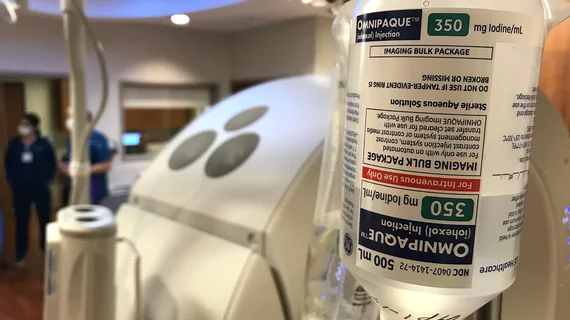'Critical' oversight of 7 factors increases contrast waste
Since the onset of the iodinated contrast shortage in 2022, countless tactics have been deployed to optimize use of the imaging agent, but many have been overlooked, the authors of a new paper in Insights Into Imaging report.
As the use of contrast has increased in recent decades, so too have efforts to understand how to best utilize it in imaging. This resulted in the deployment of power injectors that reduce excess contrast waste, weight-based protocols to optimize dosing, quicker scan times and more. Although beneficial to supply preservation, these tactics also reduce the margin for error that could create variability in image quality, authors of the new paper caution.
“There are little reserves for unexpected and unforeseen variation during data acquisition, and even small variations will have bigger negative effects on enhancement levels of the CT scan,” corresponding author Michael C. McDermott, from the Department of Radiology and Nuclear Medicine at Maastricht University Medical Center in the Netherlands, and co-authors explained. “It is therefore of utmost importance to look into the different parameters which are of major impact.”
With over 50 years of experience in research of contrast injections and nearly 10 years of experience in the engineering development of injector systems, McDermott and colleagues were well equipped to conduct an analysis on contrast preservation tactics. The team deployed several different methodologies, including engineering benchtop equipment (e.g., Coriolis flow meters, pressure transducers and volumetric measurement devices) to quantify and evaluate factors like operators, equipment and the physics and fluid dynamics at play during contrast injections.
Through this, they highlighted the following seven variables related to contrast use that affect image quality:
Choice of IV catheters: The optimal size should consider both patient factors and desired flow rate based on the requested exam. Rather than simply looking for a specific size, techs should also refer to the catheters’ packaging, which includes information on optimal gravity flow rates.
Tube line length: Longer tubing is often used to accommodate for space constraints in CT suites. However, doing so increases injection pressure and can impact dosing accuracy.
Mechanical systems of power injectors: The group explains that “a problem common to all manufacturers, regardless of delivery mechanism, is that the plastic disposables swell and stretch under the internal loads of the high injection pressures. By Conservation Law, this means that during an injection, while the expectation is that fluid is being delivered to the patient, the reality is that much of the volume is actually being injected into the expanding plastic disposables.”
Improper injector setup: When done manually, the filling of syringes or reservoirs can result in inconsistent contrast delivery.
Contrast mixing with saline: Because of their difference in density, “the heavier contrast that is either in the fluid supply or in the syringes will exchange places with the saline in the tubing set.” This can again result in improper contrast dosing
Insufficient saline flushes: This can increase contrast waste and degrade the diagnostic quality of a bolus.
Deviations from programmed injector flow rates: Any of the aforementioned factors could create “a momentary variation in flow rate that can deviate significantly from what is expected,” the group explains.
“When contrast enhancement is unexpectedly suboptimal, we often blame intrinsic patient factors or are just puzzled without knowing what to do,” the group writes, adding that these factors are “critical but commonly neglected.”

